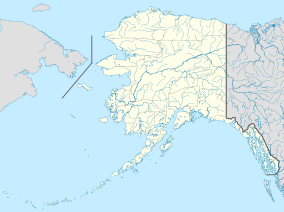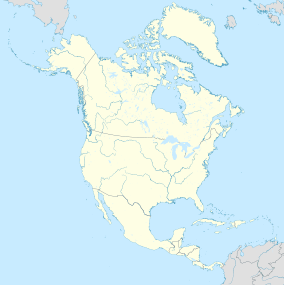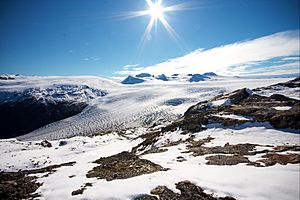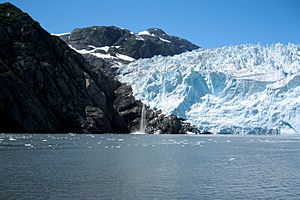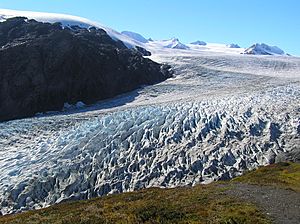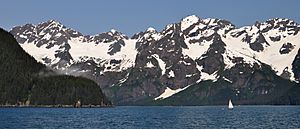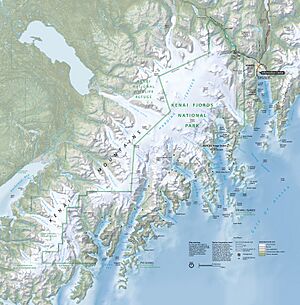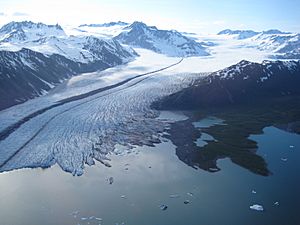Kenai Fjords National Park facts for kids
Quick facts for kids Kenai Fjords National Park |
|
|---|---|
|
IUCN Category II (National Park)
|
|
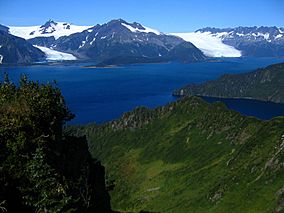
Kenai Fjords Coastline
|
|
| Location | Kenai Peninsula Borough, Alaska, United States |
| Nearest city | Seward |
| Area | 669,984 acres (2,711.33 km2) |
| Established | December 2, 1980 |
| Visitors | 321,596 (in 2018) |
| Governing body | National Park Service |
Kenai Fjords National Park is a special place in Alaska, United States. It's a national park that protects a huge area of ice, towering glaciers, and beautiful coastal fjords. Imagine deep, narrow inlets of the sea surrounded by steep cliffs! The park is located on the Kenai Peninsula and covers about 670,000 acres (2,711 square kilometers). That's a lot of land to explore!
The park is famous for the Harding Icefield, one of the biggest icefields in the United States. This giant sheet of ice feeds at least 38 glaciers, like the massive Bear Glacier. These glaciers slowly carve out the land, creating the amazing fjords you see today. Over time, these valleys filled with seawater.
One of the easiest places to visit in the park is Exit Glacier, which you can reach by road. But most of the park is wild and can only be explored by boat, plane, or on foot. Kenai Fjords National Park was officially created in 1980 to protect this unique landscape. It's home to many animals, both on land and in the sea. You might spot brown bears, black bears, moose, sea otters, harbor seals, and even humpback whales and killer whales in the waters!
Contents
The Story of Kenai Fjords National Park
Kenai Fjords National Park became an official national park in 1980. It's one of Alaska's most visited parks and is closer to the city of Anchorage than many other Alaskan parks. The park's main office is in Seward.
Early People in the Area
For a long time, people thought that early communities only visited this area for short periods. But archaeologists have found proof that people lived here for much longer! They discovered old village sites that date back to 950 AD. It's believed that some older sites might now be underwater because of earthquakes and rising sea levels. The coastline was a great place for early people to find food and resources.
Some gold mines from the past have also been found in the park, especially around Nuka Bay. Some of these mines were still active even in the 1980s!
How the Park Was Created
The idea of protecting the Kenai Fjords area started many years ago. In the 1970s, people began suggesting that this beautiful region should become a national park. There were many discussions about how to best protect the icefield and coastline.
Finally, in 1978, President Jimmy Carter declared the area a national monument. This was a temporary step to protect the land while a bigger law was being discussed. Then, in 1980, a very important law called the Alaska National Interest Lands Conservation Act was passed. This law officially made Kenai Fjords a national park!
Developing the Park
After becoming a national park, the first improvements focused on making it easier for visitors to reach Exit Glacier. Park managers decided that Exit Glacier would be the "front-country" (easy to access), while the fjords would be "back-country" (more remote), and the icefield would be a true wilderness.
Local communities, especially Native Alaskan groups, have always had a connection to this land. The park works with these communities, and some areas within the park are managed to allow traditional activities like hunting and fishing, which are important for their way of life.
Fun Things to Do in Kenai Fjords
The town of Seward is a great starting point for exploring Kenai Fjords National Park. Many people take boat tours from Seward into Resurrection Bay and the park. These tours are often led by National Park Rangers who can teach you all about the area.
On a boat tour, you might see amazing wildlife like Steller sea lions, colorful puffins, Dall's porpoises, and even huge humpback whales and orca whales! You'll also get incredible views of the fjords and glaciers that flow right into the sea. If you prefer land adventures, you can take a bus tour from Seward to visit Exit Glacier.
The park also has cabins and shelters you can use in some coastal areas and near the Harding Icefield. These are perfect for adventurers who want to stay overnight in the wilderness. The park even works with the Alaska SeaLife Center to help visitors learn more about the amazing marine life here.
Exploring the Park's Geography
Kenai Fjords National Park is located on the southeastern part of the Kenai Peninsula in Alaska. It's about 130 miles (209 kilometers) south of Anchorage. The closest big town is Seward, which sits right next to the park on Resurrection Bay.
The park is famous for its rugged coastline, which has been shaped by glaciers. It's filled with deep fjords like Aialik Bay, Harris Bay, McCarty Fjord, and Nuka Bay. A huge part of the park's interior is covered by the massive Harding Icefield. The tallest point in the park is an unnamed mountain peak in the Kenai Mountains, reaching about 6,450 feet (1,966 meters) high.
You can get to the park from Seward by driving on the Seward Highway. It's one of the few national parks in Alaska that you can reach by road! From the Exit Glacier Nature Center, you can walk on trails to see the glacier up close or even hike the 7.4-mile (11.9 km) Harding Icefield Trail.
How the Land Was Formed
The amazing landscape of Kenai Fjords was created by powerful forces deep within the Earth. Giant tectonic plates are slowly moving, with one plate sliding under another. This movement has shaped the Kenai Mountains and pulled parts of the land down towards the sea. The bottoms of the fjords can be hundreds of feet below the current sea level!
The park is covered in ice, with glaciers covering more than half of its area. The Harding Icefield gets a huge amount of snow each year, about 60 feet (18 meters)! Over thirty glaciers flow from this icefield, which first formed about 23,000 years ago. However, the icefield has been shrinking, with a 3% reduction in its size over a 16-year period. The biggest glacier in the park is Bear Glacier. The easiest one to visit is Exit Glacier, which is the only part of the park you can drive to.
Weather in Kenai Fjords
The climate in Kenai Fjords National Park is known as a subarctic climate. This means it has cool summers and gets precipitation (rain or snow) all year round. The weather can change quickly, so it's always a good idea to be prepared for different conditions when you visit!
| Climate data for Seward, Alaska (Seward Airport), 1991–2020 normals, extremes 1997–present | |||||||||||||
|---|---|---|---|---|---|---|---|---|---|---|---|---|---|
| Month | Jan | Feb | Mar | Apr | May | Jun | Jul | Aug | Sep | Oct | Nov | Dec | Year |
| Record high °F (°C) | 61 (16) |
50 (10) |
57 (14) |
74 (23) |
80 (27) |
88 (31) |
87 (31) |
86 (30) |
76 (24) |
62 (17) |
54 (12) |
52 (11) |
88 (31) |
| Mean maximum °F (°C) | 44.6 (7.0) |
44.5 (6.9) |
47.7 (8.7) |
56.3 (13.5) |
69.3 (20.7) |
74.0 (23.3) |
78.1 (25.6) |
73.6 (23.1) |
67.7 (19.8) |
55.6 (13.1) |
47.0 (8.3) |
44.8 (7.1) |
79.9 (26.6) |
| Mean daily maximum °F (°C) | 31.3 (−0.4) |
34.3 (1.3) |
37.3 (2.9) |
45.4 (7.4) |
53.4 (11.9) |
59.0 (15.0) |
62.2 (16.8) |
62.0 (16.7) |
55.7 (13.2) |
45.7 (7.6) |
36.1 (2.3) |
33.2 (0.7) |
46.3 (8.0) |
| Daily mean °F (°C) | 26.2 (−3.2) |
28.9 (−1.7) |
31.1 (−0.5) |
38.8 (3.8) |
46.3 (7.9) |
52.3 (11.3) |
56.2 (13.4) |
55.8 (13.2) |
49.6 (9.8) |
40.2 (4.6) |
31.4 (−0.3) |
28.2 (−2.1) |
40.4 (4.7) |
| Mean daily minimum °F (°C) | 21.1 (−6.1) |
23.5 (−4.7) |
24.9 (−3.9) |
32.2 (0.1) |
39.2 (4.0) |
45.7 (7.6) |
50.2 (10.1) |
49.6 (9.8) |
43.4 (6.3) |
34.7 (1.5) |
26.6 (−3.0) |
23.2 (−4.9) |
34.5 (1.4) |
| Mean minimum °F (°C) | 4.7 (−15.2) |
8.1 (−13.3) |
11.7 (−11.3) |
21.8 (−5.7) |
31.2 (−0.4) |
37.7 (3.2) |
43.3 (6.3) |
42.7 (5.9) |
34.9 (1.6) |
25.7 (−3.5) |
14.5 (−9.7) |
9.1 (−12.7) |
1.6 (−16.9) |
| Record low °F (°C) | −6 (−21) |
−15 (−26) |
2 (−17) |
10 (−12) |
28 (−2) |
35 (2) |
39 (4) |
38 (3) |
29 (−2) |
15 (−9) |
5 (−15) |
−1 (−18) |
−15 (−26) |
| Average precipitation inches (mm) | 6.47 (164) |
6.35 (161) |
3.85 (98) |
4.29 (109) |
3.50 (89) |
2.34 (59) |
3.11 (79) |
5.39 (137) |
9.90 (251) |
8.69 (221) |
7.60 (193) |
8.22 (209) |
69.71 (1,770) |
| Average snowfall inches (cm) | 12.9 (33) |
12.6 (32) |
10.5 (27) |
3.7 (9.4) |
0.3 (0.76) |
0.0 (0.0) |
0.0 (0.0) |
0.0 (0.0) |
0.0 (0.0) |
0.5 (1.3) |
8.2 (21) |
15.7 (40) |
64.4 (164.46) |
| Average precipitation days (≥ 0.01 in) | 13.6 | 13.8 | 12.4 | 14.2 | 13.5 | 11.1 | 13.4 | 15.2 | 17.1 | 16.6 | 14.0 | 15.9 | 170.8 |
| Average snowy days (≥ 0.1 in) | 5.8 | 5.0 | 4.7 | 2.2 | 0.1 | 0.0 | 0.0 | 0.0 | 0.0 | 0.8 | 3.9 | 6.7 | 29.2 |
| Source 1: NOAA (average snowfall/snow days 1981–2010) | |||||||||||||
| Source 2: National Weather Service | |||||||||||||
Amazing Wildlife and Nature
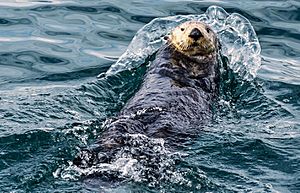
Kenai Fjords National Park is a wild place where glaciers have shaped the land. As glaciers melt and retreat, they uncover new land. This new land then becomes home to different plants and animals. The park also has a rich marine environment, meaning lots of life in the ocean!
Animals of Kenai Fjords
You can find many large land animals here, like wolves, porcupines, lynx, brown bears, black bears, moose, and mountain goats. Smaller animals include coyotes, beavers, and river otters.
In the ocean waters, you might spot sea otters, harbor seals, and huge Steller sea lions. Many types of whales and dolphins also live here, such as orcas (killer whales), fin whales, humpback whales, minke whales, Dall's porpoises, and Pacific white-sided dolphins.
Many birds make their nests in the park, including the majestic bald eagle, peregrine falcons, black-billed magpies, and Steller's jays. Along the coast, you'll see marine birds like tufted and horned puffins, common and thick-billed murres, and marbled murrelets.
Plant Life and Growth
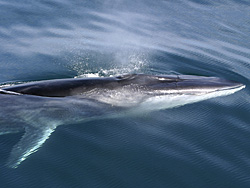
The plant communities in Kenai Fjords change a lot as glaciers retreat. When new land is exposed, it's mostly rocky with no soil. The first plants to grow are tiny lichens and mosses, along with tough plants like dwarf fireweed. These "pioneer" plants help break down rocks and create soil.
Then, other plants start to grow, like Sitka alders, which help make the soil richer. Willows also appear. After a while, black cottonwoods and Sitka spruce trees grow. In the mature forests, you'll find Sitka spruce and mountain hemlocks, with plants like devil's club, Alaska blueberry, and elderberry growing underneath.
At higher altitudes, it's too cold and windy for tall trees to grow. This creates an alpine ecosystem, where you'll find smaller shrubs and herbaceous plants like grasses, Nootka lupine, and fireweed. Even higher up, you'll see tiny dwarf plants that grow very slowly, like bog blueberry and black crowberry. These small plants are very delicate, so it's important to be careful where you step!
The Fjord Estuary Ecosystem
Kenai Fjords has a special kind of estuary. This is where fresh water from melting glaciers mixes with salty ocean water. The glaciers grind rocks into a fine powder called "rock flour," which colors the water. This rock flour carries minerals that help tiny ocean plants called phytoplankton grow. These phytoplankton are the base of the food chain, supporting all the larger animals in the fjord!
A Past Oil Spill Event
In 1989, an oil spill happened in a nearby area. Some of this oil reached parts of the Kenai Fjords coastline. Park staff worked quickly to protect salmon streams and check on plants and animals that might be affected. About 20 miles (32 kilometers) of the coastline were impacted.
Cleaning up the oil was very difficult because it turned into a thick, sticky tar. Cleanup efforts continued for several years. This event also helped archaeologists discover an ancient beach site, showing that people had used parts of the park for a very long time.
See also
 In Spanish: Parque nacional de los fiordos de Kenai para niños
In Spanish: Parque nacional de los fiordos de Kenai para niños


